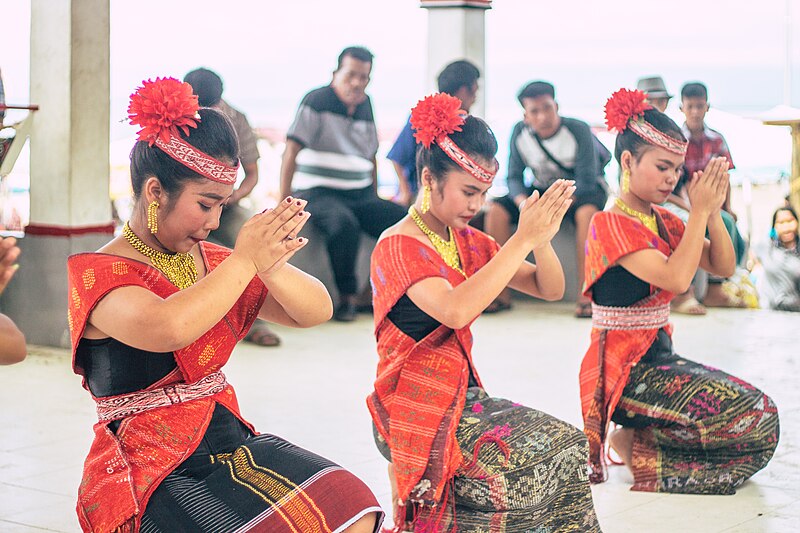
Robert Draws – The Function of Tari Tor Tor extends far beyond its captivating movements and rhythmic beats. Originating from the Batak people of North Sumatra, Indonesia, Tari Tor Tor is a traditional dance that has played an essential role in the Batak culture for centuries. This dance, with its powerful symbolism and spiritual undertones, is much more than an artistic performance; it is a medium of communication with ancestors and the Creator, a reflection of community values, and a key element in various cultural ceremonies. The name Tor Tor itself is derived from the sound produced by the dancers’ feet striking the wooden floors of Batak traditional houses, symbolizing the connection between the earthly and the spiritual realm. Through its movements, Tari Tor Tor conveys deep messages about life, spirituality, and social harmony.
The origins of Tari Tor Tor can be traced back to the ancient Batak people, around the 13th century. Initially, the dance was performed during sacred rituals, serving as a form of communication with the spiritual world and the ancestors. Shamans, or datu, would perform Tari Tor Tor as part of ceremonies meant to invoke blessings or to heal the sick.
With the arrival of Hindu-Buddhist influence in Sumatra, Tari Tor Tor began to evolve. New elements, such as the introduction of the gondang (traditional Batak drums) and ulos (Batak ceremonial cloth), became part of the dance. What was once performed exclusively by spiritual leaders eventually became a dance for the wider community. Often showcased in various cultural ceremonies and festivals.
During the Dutch colonial era, Tari Tor Tor also became a symbol of resistance. The dance’s rhythmic sounds and symbolic movements were used to communicate hidden messages, especially during times of conflict. Today, Tari Tor Tor continues to thrive as an essential element of Batak culture, having gained recognition both locally and internationally, all while retaining its rich spiritual and cultural roots.
“Read about: RockStar Academy’s Broadway Debut: A Star-Studded Performance You Can’t Miss!”
Tari Tor Tor is not just one dance; it encompasses several variations, each with distinct meanings and functions. Below are some of the most prominent forms:
Performed to purify a space before significant events, this dance is intended to rid the area of negative energy. It is often accompanied by symbolic items, such as jeruk purut (kaffir lime), used for purification.
A ceremonial dance performed during the coronation or installation of a Batak king. The dance is inspired by a legend involving seven heavenly maidens and symbolizes the nobility and authority of a leader.
This form of Tor Tor is performed by shamans during rituals to expel evil spirits or seek guidance during times of disaster. It is a form of spiritual healing and protection for the community.
A dance of respect, performed to honor elders or distinguished guests. Its graceful movements symbolize humility and reverence.
Often performed by the youth, this dance symbolizes joy and hope for the future. It is typically featured at weddings and other celebratory events.
Each type of Tari Tor Tor is distinct in its movements, music, and costumes, but they all share a core purpose: to communicate, to convey spiritual messages, and to foster community unity.
Despite the variations, there are several signature movements that characterize Tari Tor Tor. Each of these movements holds profound philosophical meaning:
While these movements may appear simple, each one is imbued with deep philosophical significance, reinforcing the Batak people’s values and way of life. Through Tari Tor Tor, these values are passed down to future generations.
“Read more: The Latest Nail Art and Skincare Trends Taking Women by Storm”
Tari Tor Tor is integral to the social and cultural fabric of Batak society. It serves various functions, such as:
Originally a sacred dance, Tari Tor Tor has been used in rituals to communicate with ancestors and the Creator. It is performed during significant life events, such as births, weddings, and funerals, to invoke blessings and protection.
The dance fosters a sense of community and solidarity. When performed together, it strengthens social bonds and brings people together, creating a space for cooperation and unity.
Through Tari Tor Tor, younger generations learn about their cultural heritage and important societal values, such as respect for elders, humility, and community spirit. In some schools in Batak regions, the dance is incorporated into the curriculum to help preserve this important cultural tradition.
As a form of artistic expression, Tari Tor Tor is admired for its beauty. The graceful movements, elaborate costumes, and vibrant music make it a captivating performance enjoyed by audiences both locally and internationally.
With its growing popularity, Tari Tor Tor has become a source of income for many artists and performers. The tourism industry around Batak culture has also flourished, with many visitors coming to witness the dance as part of cultural heritage tours.
On a global scale, Tari Tor Tor serves as a representation of Batak culture and Indonesian heritage. It has been showcased in international festivals, helping to promote the richness of Indonesian traditions and fostering cultural diplomacy.
The multifaceted functions of Tari Tor Tor highlight its importance not only as a form of entertainment but as a vital component of Batak identity and cultural preservation.